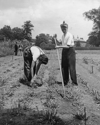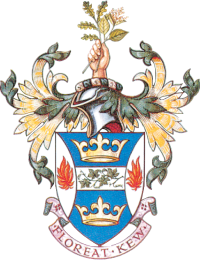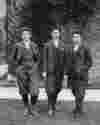The History of the Kew Guild
For more than a century the Kew Guild has been the thread of continuity that binds present staff and students to those that have gone before.
The Archives
To this date, the Kew Guild maintains a physical archive of historical papers, the majority of which have been deposited with the Royal Botanic Gardens Kew Archive who now retain ownership and ongoing management of the collection. Parts of the archive collection are also stored with individual members of the Guild.

Lady gardeners at Kew, 1939 - ‘45

Kew Guild Journals
Back-copies of the Journal of the Kew Guild have been digitised and are available to browse and search. The Journal provides an unbroken annual record of Kew and the Guild since 1893, and is a continuing channel of information.
Founded in 1893
The Kew Guild was founded in 1893, as an offshoot of the Kew Mutual Improvement Society (itself created in 1871), with an intention of uniting past and present horticulturists and scientists by means of the publication of an annual journal that would convey news and facilitate communication. The Director, William Thiselton-Dyer, gave his blessing and a committee was formed to carry out the scheme, consisting of W.Watson, W.J. Bean, G.H. Krumbiegel, J. Brown, A.A. Pettigrew and J. Aikman.
At this time, the fledgling organisation also adopted its motto, ‘Floreat Kew’, meaning ‘May Kew Flourish’. A badge for the Guild was first developed in the 1920s. Improvements were made to this in the 1930s but the design was not appropriate from a heraldic point of view and so, in the 1960s, the Guild approached the College of Arms and an official badge and arms were awarded.
The Kew organisation adopted its motto, ‘Floreat Kew’, meaning ‘May Kew Flourish’.
Initially, the Guild was intended only for gardening staff but, in 1898, this rule was expanded to include those “who are or who have at any time been employed as gardeners or in any position of responsibility in the Royal Gardens, Kew”, to become members.
Change for the better
Among those who became life members early on were Sir Daniel Morris, Sir Joseph Hooker and Sir William Thiselton-Dyer. In 1937, volunteer student gardeners were also admitted to the Guild under the category ‘Associate-Membership’. The worldwide membership now also includes International Trainees, Research and Liaison Scientists, Diploma and Postgraduate Students and, at the discretion of the Committee, other individuals who have had an association with Kew.
At its inception, the Guild Journal was intended to provide a vehicle for the publication of the Mutual Improvement Society’s Annual Prize Essay. The Journal provides an unbroken annual record of Kew and the Guild since 1893, and is a continuing channel of information about the Gardens as well as about the fortunes of current and former staff and students across the world. Its original, successful format has changed little over the years.
There have been a number of periods of concern for the Guild, for example during the financial depression of 1931-2 (when publication of the Journal was delayed), the First World War (when the Journal was reduced and the Annual Dinner abandoned), and the Second World War (when the Journals for 1939 and 1940 were amalgamated).
The most serious constitutional crisis for the Guild occurred in 1908 when a number of members desired to use the Guild to put pressure on the government for a rise in salaries for the gardening profession in general, a move that went against the fundamental principle that the Guild should not be used for political purposes. Eventually, this proposal was abandoned but not without the resignation of a number of members and the absence of a journal for 1909. The Journal for 1918 contains a Roll of Honour and a war memorial was erected by the Guild in the Temple of Arethusa.
History
Biographies of The Guild
Discover and explore the timeline of our past friends of Kew Gardens and Wakehurst.

Kew’s World Garden: A 1940s film was discovered by chance when Michele Losse, Assistant Archivist at RBG Kew and Archives Liaison officer for the Kew Guild, was perusing through a 1941 publication of the Guild’s journal. Michele then located the film at the British Council and its discovery led to its restoration.
The film which, according to the film Director, provided a moment of solace in the midst of war.
“At Daffodil time the 'Blitz' was still on, and I began to quite look forward to slipping down to Kew. Within an hour the war was forgotten: things were growing at Kew: people were building instead of destroying... Here was sanity in a mad world
The future of The Guild
Throughout its history, the Kew Guild has donated prizes to be awarded to student gardeners. Initially, they were presented at the annual dinner but are now given on the same occasion as the Kew Diploma and other non-Guild awards. The Guild has also been involved in helping individuals suffering hardship and, in the early 1970s, a proposal was put forward which resulted in the Award Scheme which sponsors and administers bursaries, awards and travel fellowships that are open to all members.
In 1962, the Guild applied for charitable status, a request which was granted on appeal in 1964, thus increasing the Guild’s income by ceasing its liability for income tax.
As a result of this, fundraising functions have also become a regular undertaking of the Guild.


